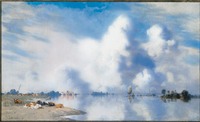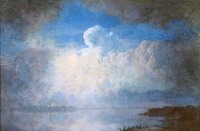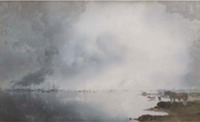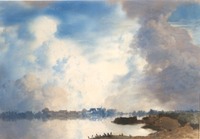Jan Voerman rainy weather at the river IJssel
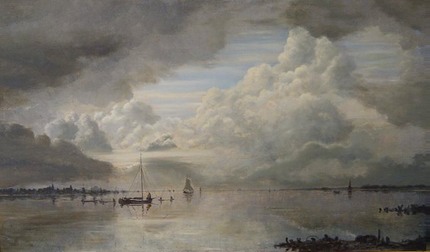
Jan Voerman (1857 -1941) was a farmer's son and grew up near the river IJssel. Destined to become a farmer, he escaped farmer's life because one of his teachers observed his artistic talent. He left the countryside to study at the State Academy in Amsterdam and the Academy of Antwerp. At both academies he was educated in the classic academic tradition. Outside the academy in Amsterdam he became acquainted with the modern impressionist way of painting practised by young painters like Breitner and Isaac Israels. In the beginning of his career he painted in the way he was educated but soon he started to experiment with a more impressionist way of painting. He was impressed by Breitner and Breitner himself liked his work. He lived near the studio of Isaac Israels and it is said they sometimes worked together on the same subject. Although he made some portraits in his early period the farmers's son Voerman was a born landscapepainter. His love was the landscape near the river IJssel where he was born. During his Amsterdam period in summer he usually stayed in the countryside near the IJssel to paint landscapes. In 1889 Voerman married with Anna Verkade and moved to Hattem, a small town near the river IJssel. In the course of the years he built his own painters paradise on a dike of the IJssel just outside Hattem. In the beginning of the nineties and inspired by post-impressionist painters like Jan Toorop, he experimented with colour, shape and the reflection of feelings. He used pure colours, clear lines and flat shapes. Through his brother in law, the painter Jan Verkade - for a short time a pupil of Gauguin - he became acquainted with the ideas of a French post-impressionist group of painters around Gauguin, the Nabis (the prophets) His agent who had to sell his paintings was less enthousiastic because of the criticism on his new way of painting. Later Voerman himself called this period his theoretical stage. After some years he retuned to a more impressionist style. But his palette remained more pure and with his brush he kept trying to disclose the grand mysteries of nature. His atmospheric vieuws of the river IJssel with cloudy skies towering above the river like cathedrals are the best efforts of this endeavour. It earned him a distinct place in the Dutch tradition of landscape painting. Recently Dutch meteorologists studied the clouds on his paintings and came tot the conclusion that in reality these weather types do not exist. I agree with them, the cloudy skies were rather an expression of the soul of the painter. Like Voerman himself said at the end of his life: In reality clouds are never like I painted them, they are like my inner side .....

